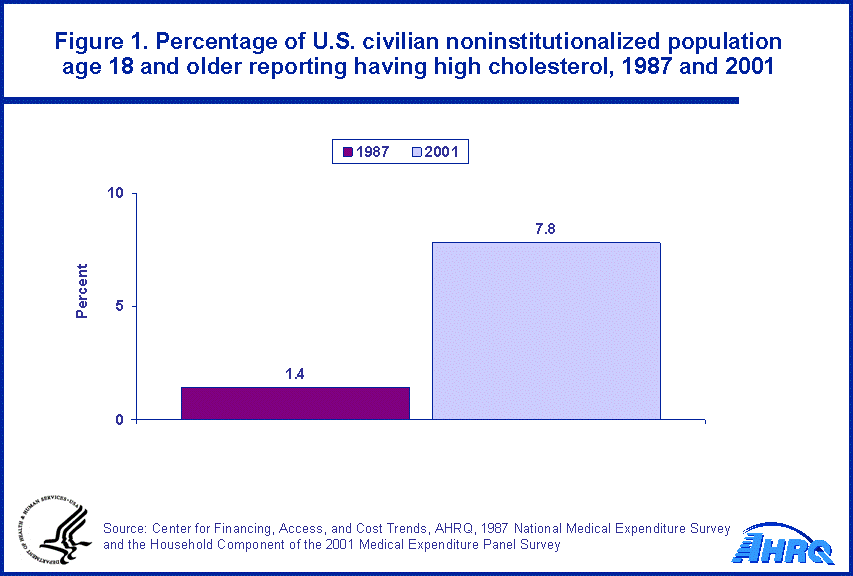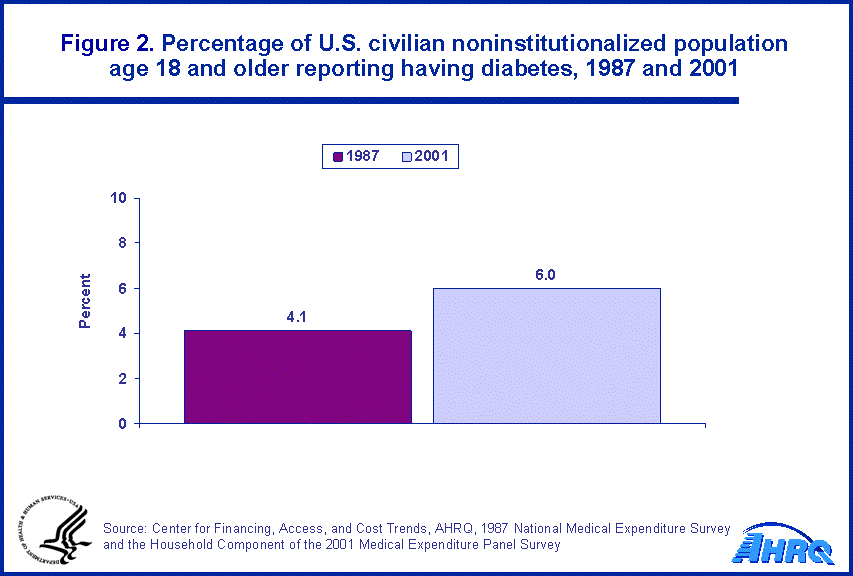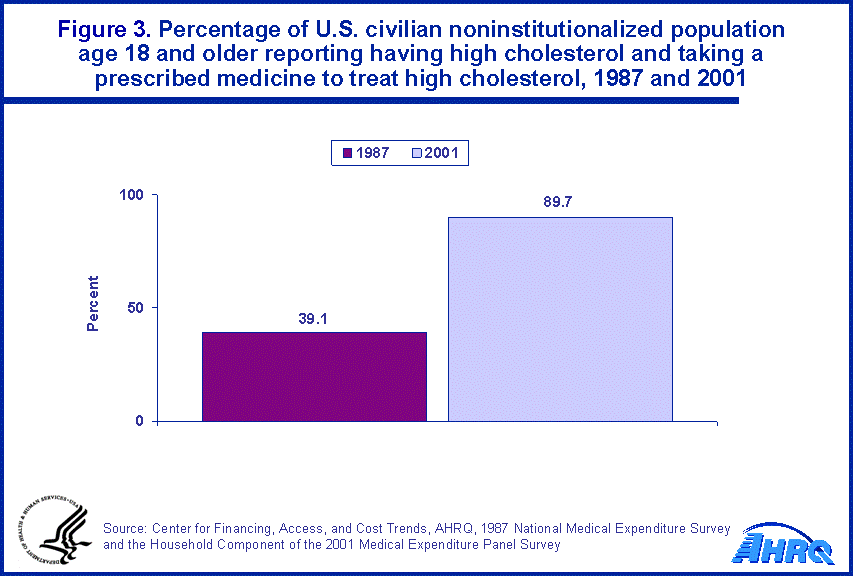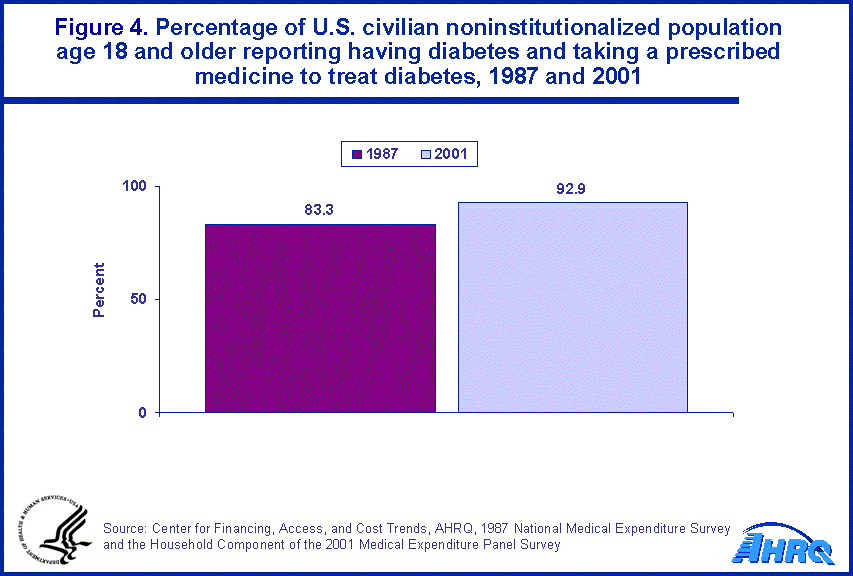
|
|
Font Size:
|
||||
|
|
|
|
||||
STATISTICAL BRIEF #58:
Chronic Conditions and Outpatient Prescription Medicines for Persons 18 and Older in the U.S. Civilian Noninstitutionalized Population, 1987 and 2001
Highlights
- The percentage of adults who reported having high cholesterol was over five times higher in 2001 (7.8 percent) than in 1987 (1.4 percent).
- Of the percentage of adults who reported having high cholesterol, those who reported taking a prescribed medicine to treat high cholesterol more than doubled from 1987 (39.1 percent) to 2001 (89.7 percent).
- The percentage of adults who reported having diabetes increased nearly one and one-half times when comparing 1987 to 2001 (4.1 percent versus 6.0 percent).
- The percentage of adults who reported having diabetes and taking a prescribed medicine to treat diabetes increased when comparing 1987 (83.3 percent) to 2001 (92.9 percent).
Introduction
This Statistical Brief compares data from 1987 and 2001 on the use of prescribed medicines in the U.S. civilian noninstitutionalized (community) age 18 and older (adult) population as part of the treatment for specific chronic conditions. Statistics from 1987 and 2001 are presented on the percentage of the adult community population who reported having a selected condition and the percentage receiving a prescribed medication as treatment for that condition. This brief, the third in a three-part series comparing statistics from 1987 and 2001 on selected conditions and outpatient prescribed medicines utilization and expenditures,1 provides information on how the use of prescribed medicines to treat selected chronic conditions in the adult community population has changed over time.
The data used to estimate the statistics in this brief are derived from the 1987 National Medical Expenditure Survey (NMES) and the Household Component of the 2001 Medical Expenditure Panel Survey (MEPS-HC). All results discussed are statistically significant at the 0.05 level. Over-the-counter medicines and free samples are not included in these estimates.
Conditions in this brief are household-reported conditions that are coded by professional medical coders using the International Classification of Diseases, Ninth Revision (ICD-9). Condition categories were aggregated into clinically meaningful categories by using Clinical Classification Software (CCS), which was formerly known as Clinical Classifications for Health Policy Research (CCHPR). Adults with a condition in this brief are defined as those who reported the condition as the reason for use of medical care during the year. Adults with a condition who did not report receiving any medical visits or prescribed drugs for the condition in the reference year are excluded from this analysis.2 Prescribed medicines that linked to more than one condition category were represented in all categories mentioned by the respondent.
Findings
In 1987 and 2001, the percentages of the U.S. community adult population who reported having high blood pressure, heart disease, diabetes, and high cholesterol were as follows:
1987 |
2001 |
|||
| Household-reported condition | Number of adults who reported condition | Percentage of total adult population | Number of adults who reported condition | Percentage of total adult population |
| High blood pressure | 23.2 million |
13.5 |
33.9 million |
16.0 |
| Heart disease | 13.0 million |
7.6 |
15.9 million |
7.5 |
| Diabetes | 7.0 million |
4.1 |
12.7 million |
6.0 |
| High cholesterol | 2.4 million |
1.4 |
16.6 million |
7.8 |
The percentage of the community adult population who reported having high cholesterol increased over fivefold when comparing 1987 to 2001 (1.4 percent to 7.8 percent) (figure 1). The percentage of adults who reported having diabetes (4.1 percent versus 6.0 percent) increased just under one and one-half times when comparing 1987 and 2001 (figure 2). In 2001, a higher percentage of the community adult population reported having high blood pressure (16.0 percent) when compared to the percentage reported having high blood pressure in 1987 (13.5 percent). The percentage of the community adult population who reported having heart disease did not change significantly when comparing 1987 and 2001.
In 1987 and 2001, the percentages of the U.S. community adult population who reported having high blood pressure, heart disease, diabetes, and high cholesterol and taking a prescribed medicine to treat those conditions were as follows:
1987 |
2001 |
|||
| Household-reported condition | Number of adults who reported taking a prescribed medicine for condition | Percentage of adults who reported taking a prescribed medicine for condition | Number of adults who reported taking a prescribed medicine for condition | Percentage of adults who reported taking a prescribed medicine for condition |
| High blood pressure | 21.8 million |
94.1 |
32.7 million |
96.5 |
| Heart disease | 10.6 million |
81.3 |
12.2 million |
76.5 |
| Diabetes | 5.8 million |
83.3 |
11.8 million |
92.9 |
| High cholesterol | .9 million |
39.1 |
14.9 million |
89.7 |
The percentage of the community adult population who reported having high cholesterol and having purchased a prescribed medicine to treat high cholesterol more than doubled from 1987 to 2001 (39.1 percent to 89.7 percent) (figure 3). When comparing 1987 to 2001, the percentage of adults who reported having diabetes and purchasing a prescribed medicine to treat diabetes increased as well (83.3 percent to 92.9 percent) (figure 4). There was no significant change in the percentage of those adults who reported having heart disease and purchasing a prescribed medicine to treat heart disease when comparing 1987 to 2001, and there was also no significant increase or decrease in the percentage of adults who reported having high blood pressure and having purchased a prescribed medicine to treat high blood pressure when comparing 1987 and 2001.
About MEPS and NMES
The Medical Expenditure Panel Survey (MEPS) is the third in a series of nationally representative surveys of medical care use and expenditures. MEPS is cosponsored by the Agency for Healthcare Research and Quality and the National Center for Health Statistics. MEPS collects nationally representative data on health care use, expenditures, sources of payment, and insurance coverage for the U.S. civilian noninstitutionalized population. The first survey, the National Medical Care Expenditure Survey (NMCES) was conducted in 1977; and the second survey, the National Medical Expenditure Survey (NMES), was carried out in 1987.
NMES and MEPS data are released to the public in public use data files. NMES data files are available from the AHRQ Publications Clearinghouse (E-mail: ahrqpubs@ahrq.gov). MEPS data files are available on the MEPS Web site (http://www.meps.ahrq.gov).
References
For a detailed description of the MEPS-HC survey design, sample design, and methods used to minimize sources on nonsampling error, see the following publications:
Cohen, J. Design and Methods of the Medical Expenditure Panel Survey Household Component. MEPS Methodology Report No. 1. AHCPR Pub. No. 97-0026. Rockville, Md.: Agency for Health Care Policy and Research, 1997.
Cohen, S. Sample Design of the 1996 Medical Expenditure Panel Survey Household Component. MEPS Methodology Report No. 2. AHCPR Pub. No. 97-0027. Rockville, Md.: Agency for Health Care Policy and Research, 1997.
For more information on the method in which clinical classification codes were aggregated into meaningful categories, please see the following:
Healthcare Cost and Utilization Project (HCUP) Clinical Classifications Software (CCS). Rockville, Md.: Agency for Healthcare Research and Quality, November 2004. Available on the AHRQ Web site at http://www.hcup-us.ahrq.gov/toolssoftware/ccs/ccs.jsp.
For more information on the NMES survey design, see the following publications:
Cohen, S., R. DiGaetano, and J. Waksberg. Sample design of the 1987 Household Survey. AHCPR Pub. No. 91-0037. National Medical Expenditure Survey Methods 3. Agency for Healthcare Policy and Research. Rockville, Md.: U.S. Department of Health and Human Services, Public Health Service, 1991.
Edwards, W. and M. Berlin. Questionnaires and data collection methods for the household survey and the survey of American Indians and Alaskan Natives. DHHS Pub. No. (PHS) 89-3450. National Medical Expenditure Survey Methods 2. National Center for Health Services Research and Health Care Technology Assessment. Rockville, Md.: U.S. Department of Health and Human Services, Public Health Service, 1989.
For more information for consumers about prescribed medicines and taking them safely, see Your Medicine: Play It Safe, a guide developed by AHRQ and the National Council on Patient Information and Education and available on the AHRQ Web site at http://www.ahrq.gov/consumer/safemeds/safemeds.htm.
For more information about maintaining good health for adults, see The Pocket Guide to Good Health for Adults, developed by AHRQ and available on the AHRQ Web site at http://www.ahrq.gov/ppip/adguide/.
Suggested Citation
Stagnitti, M. N. and Pancholi, M. Chronic Conditions and Outpatient Prescription Medicines for Persons 18 and Older in the U.S. Civilian Noninstitutionalized Population, 1987 and 2001. Statistical Brief #58. December 2004. Agency for Healthcare Research and Quality, Rockville, MD. http://meps.ahrq.gov/mepsweb/data_files/publications/st58/stat58.shtml
Footnotes
1 Statistical Briefs #33, #43, and #58
 |
||||||||||||
|
||||||||||||
|
|
||||||||||||
 |
||||||||||||
|
||||||||||||
|
|
||||||||||||
 |
||||||||||||
|
||||||||||||
|
|
||||||||||||
 |
||||||||||||
|
||||||||||||
|
|
||||||||||||


